All About Crazy Patchwork
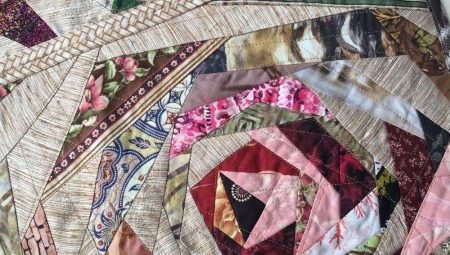
Patchwork is incredibly cozy, creative and technologically interesting handicraft. Blankets, pillows, carpets and other accessories made in this style adorn Scandinavian interiors and boho spaces and are used by bloggers to create attractive photo content. But if the usual patchwork no longer impresses with its novelty, you can try one of its ramifications. It's called - "Crazy Patchwork".

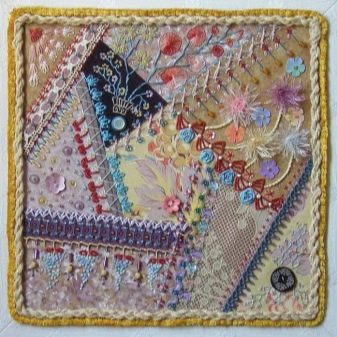
History
This style will suit those women who are guided primarily by freedom in creativity.
Unexpected combinations of colored patches, combined with hand embroidery, allow you to create amazing canvases. They, like Bosch's paintings, I want to consider to the smallest detail.
But you can also add lace applique and beaded embroidery to the crazy patchwork. There are practically no limits to the embodiment of a creative idea.
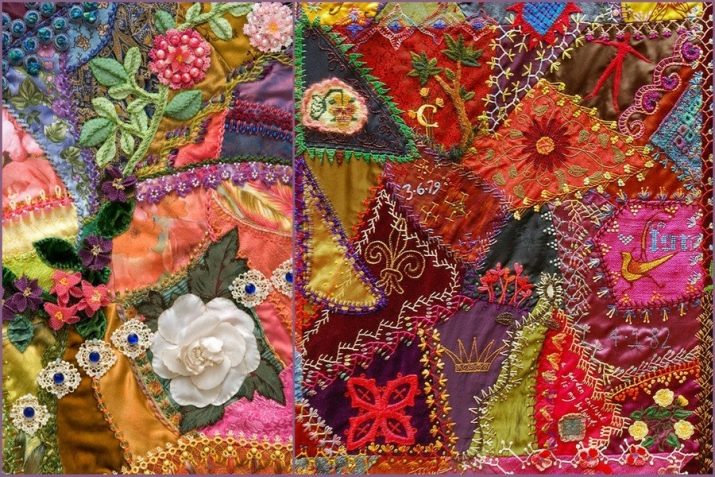
You can translate the name of the direction as "crazy patch". Technique appeared in England, and in the Victorian era. It would seem that the prim traditions of this country are hardly compatible with such a cheerful and humorous style of needlework, but the fact remains. Crazy patchwork appeared in parallel with the standard geometric, but the purpose of the products of the two styles was different.
Patchwork arose for reasons of economy, when zealous housewives acted according to the proverb "the need for invention is cunning." Crazy patchwork was a luxury, devoid of practical orientation in style. I must say that the creative direction would hardly have developed so quickly if it were not for the appearance of a sewing machine. This was a breakthrough, which, of course, was used by wealthy needlewomen.But it was the sewing machine that gave the patchwork a special development, complicated the concept itself.
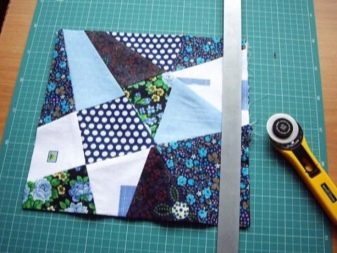
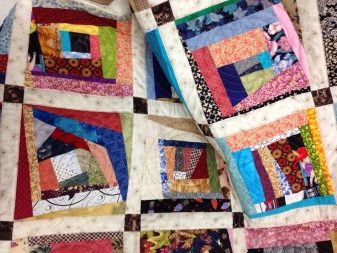
It would be unfair not to note that the "crazy shred" also has Japanese roots. Quilted embroidery was especially honored by the Japanese. The fabric was treated with great respect, each piece was preserved and found new life in quilted things. In the middle of the nineteenth century, Japan opened up to foreign trade, and it was the wives of the British who worked in Japanese ports that brought Victorian handicrafts to the East. Then patchwork became not only a way to prolong life of things, but turned into an art.
Traditions, techniques, handicraft technologies of the two worlds combined, combined, penetrated each other - this is how patchwork took over the whole world. And the crazy patchwork has become a kind of this creativity - a variation that attracts those who love freedom of decisions, originality of composition and many author's inclusions.
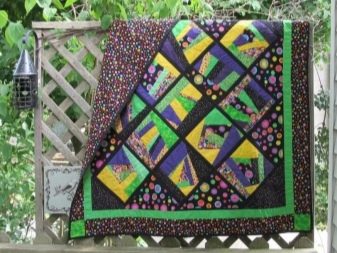
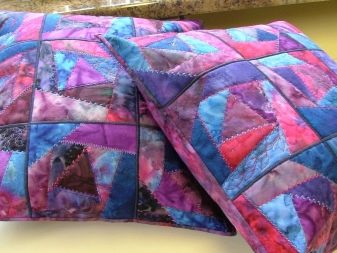
Features of technology
Ordinary patchwork is the connection between the details of the overall composition. It is enough to lay out the pieces of fabric according to the sketch and simply fasten it in a convenient and correct way. Crazy patchwork isn't all that fast. When the details are sewn, the seams need to be masked with artistic embroidery. Several types of stitching are used - "goat", "goose foot", "chain". Then the embroidery is combined with lace and ribbon appliqués, beads, buttons, beads.
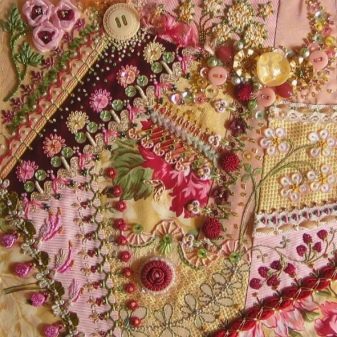

Any decorative details become part of the composition: ribbons - flower stalks, beads - buds, beads - flower cores.
It is in the combination of different decorative designs that harmoniously coexist on one patchwork field that the charm of a crazy patchwork lies.
Overview of stitch types
There was a time when in labor lessons girls were taught to make a variety of stitches - from simple to highly artistic. And fabric samples with such stitches were sewn into a book. If someone still has this book, it can remind you of the beauty of handcraft and inspire a crazy patchwork. Stitches play an important role in this craft.
Even before the creation of the first product in the patchwork technique, you can organize yourself a "simulator" of decorative seams. Crazy patchwork decoration is of great importance because it makes sense to practice stitches separately.
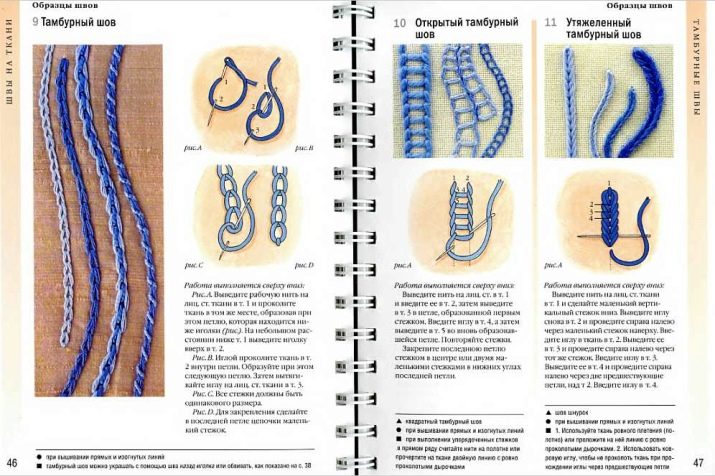
The stitches can be very different:
- chain stitch - performed from right to left;
- looped seam - resembles a zigzag, has an external resemblance to a twig with leaves;
- herringbone seam - a variant of an open chain stitch;
- goat - looks like a cross, but still not it;
- double goat seam;
- chain seam - one link comes out of the other;
- chain with leaves;
- plume - looks like a bird's footprint;
- overlock stitch - traditional, but very much in demand.
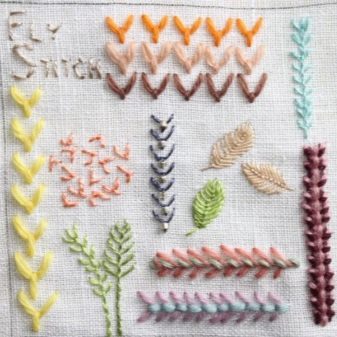

In fact, there are a lot of decorative seams, curvilinear, openwork, complex. There are original findings, there are amazing combinations that are "art in art": that is, they are interesting in and of themselves, outside of the crazy patchwork, but against its background the stitches give the product a special value.
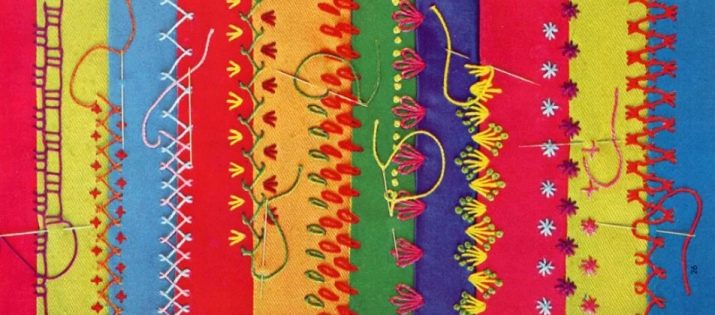
Cut fabrics
There is a conventional concept that fabrics of equal density and texture should be used in patchwork. And the very geometric shapes that make up the canvas are determined by the sketch. Complex elements and transitions, oval inserts in a crazy patchwork are rarely used.
Usually, novice needlewomen do something simple, for example, napkins. But even a small napkin without a preliminary sketch is difficult to make... Although, if you have certain artistic skills, and without a preliminary scheme, everything will work out. The patchwork pattern can be assembled on paper. It shows a layout diagram, fabric pieces are superimposed on top, on the places planned for them.

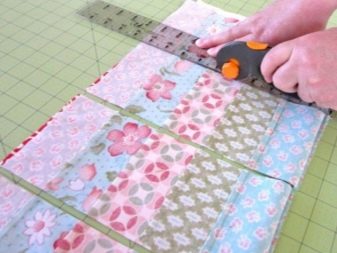
Features of collecting blocks
There are several ways to build. Each creates its own decorative effect. Some assemblies are better for bags, some for pillows.
Block assembly options.
- Antique... Typical for Victorian quilts. The pattern of the flaps comes with allowances, they are laid out on the base with overlapping each other, fixed with pins. Then the author adds braid and lace. If everything suits you, the shreds are alternately split off, the allowances are smoothed out, swept onto the base. Then all seams are secured with embroidery.
- Landscape... Similar to the previous one, except that the allowances have to be ironed right away. Rounded pieces can also be used here. Usually the craftsman starts sewing from the top of the block, layering the shreds.
- Face-to-face assembly. The first flap is placed on the base, the second is laid face down on it, edge to edge, after which the fragments can be sewn on. Before sewing on the next piece, you need to decide how the braid or lace will be positioned.
- Base assembly is another face-to-face option. A block diagram is made, transferred to the base. Templates are cut out of it, and fragments are already cut along them, taking into account the seam allowances. Next, they need to be assembled on the basis with sewing along the indicated lines.
- Build in stripes. And this is also a face-to-face option. A strip of matter becomes the basis, one by one, randomly shaped patches are sewn onto it.
- Shards... The block is assembled on a sewing machine. You need to take 8 different fabrics, which are sewn in two blocks of 4 fragments. Each block is randomly cut diagonally, the pieces are swapped, stitched, cut again, stitched all together and aligned to a square block.
- Collage and stained glass. Beautiful assembly with tuning everything at once. For an additional effect, different sewing threads are taken - silk, metallic, multicolor.


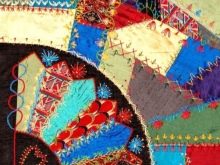
In books on crazy patchwork, these methods are understood in detail. Handbooks for needlewomen can be considered the works of J. Montano and M. Michler.
What can be done?
The "crazy patch" looks nice and easy, but behind this exquisite handicraft lies the most real painstaking manual labor. However, with ideas for inspiration that infect hand-made lovers, even the most difficult stages of work become enjoyable and mesmerizing.
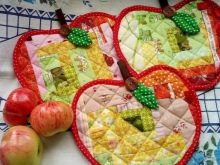

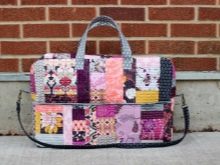
A bag
A step-by-step scheme for sewing a bag will not scare even beginners, because the potential result is worth any effort.
For sewing you need:
- beautiful pieces of fabric;
- thick fabric for the base - flax will do;
- threads and scissors, a needle;
- pencil and paper;
- decorative items for decorating crafts.

An approximate MK plan for sewing a bag in the style of a crazy patchwork.
- In the center of the bag will be the most beautiful flap with an eye-catching image. But, as an option, you can make the central fragment in a single color, decorating it with a sparkling large stone or a beautiful brooch, embroidered with ribbons.
- First, a paper pattern is made, it is transferred to the base fabric. Parts are cut taking into account seam allowances.
- After cutting and trying on, the flaps must be sewn one by one, followed by ironing.
- After sewing the patches, you need to decorate the joints with lace, braid, decorative seams.
You can sew a lining for a bag, sew in a zipper and enjoy the result of a lot of creative work.
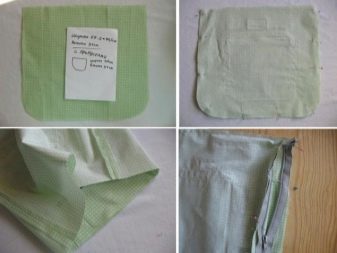


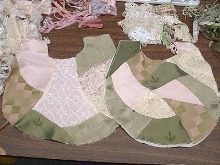
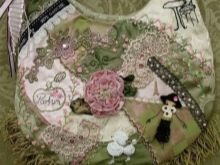
Pillow
The assembly principle is the same. Cut many colored parts of different shapes, lay them out on a diagram drawn on paper. Details are attached according to the scheme. Each piece is sewn on and smoothed with an iron. The most interesting thing begins only now: if before that it was possible to sew on a typewriter, then further actions will have to be done literally with your own hands.
Decorative seams are something that will definitely be paid attention in the case of a pillow. Appliques, buttons, braid and lace are not as important here as interesting stitches and unusual stitches.
Experienced craftswomen recommend turning off logic at this stage of execution and using imagination.
From rags in a crazy patchwork, they do not sew the pillow itself, but a cover for it. Covers can be zipped or fixed with buttons.
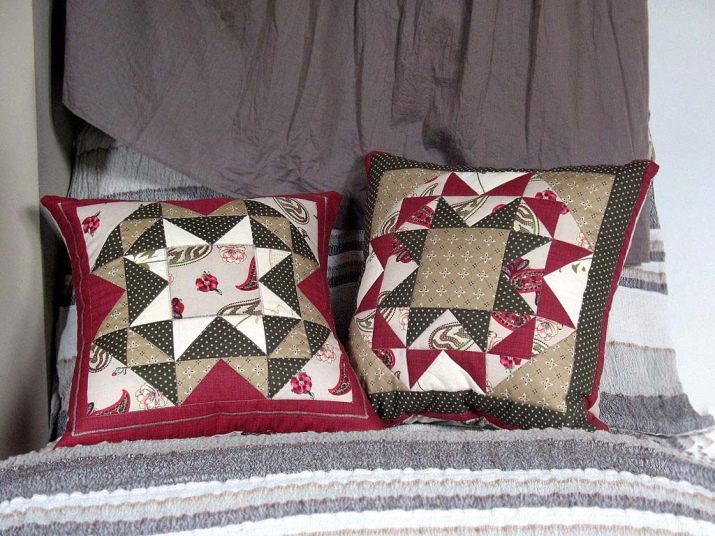
Potholder
For many needlewomen, the first patchwork master class is associated with an oven mitt. This product consists of the following parts:
- front side made in patchwork technique;
- the side of the mitten made of plain fabric;
- cushioning layer or insulation;
- two inner linings.
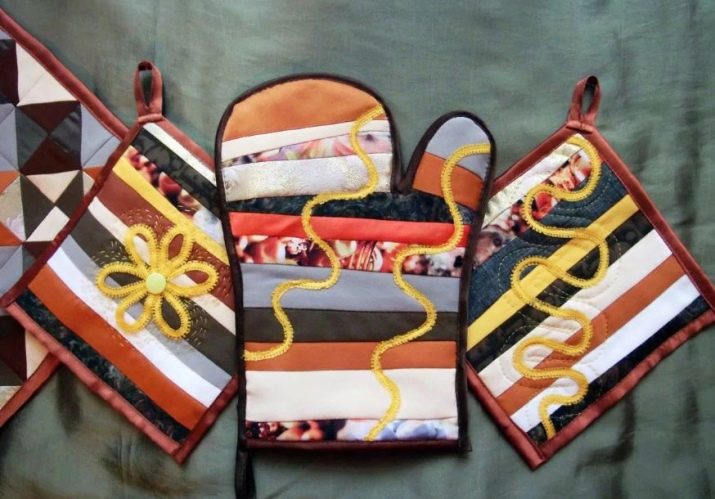
You can sew the patches in the same way as it is done in the classic patchwork - geometrically exactly. But here's the design of the seams to borrow from the crazy patchwork. There should not be many decorative details on the potholder, otherwise it cannot be utilitarian. Although if such a thing is created only for decoration, then even knitted roses with beaded cores and complex volumetric appliqués may well be placed on a potholder.

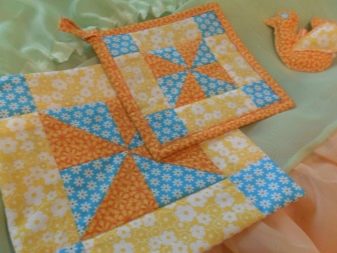
Other things
Quilt - art in which the patchwork technique is applied implies the coverage of a wide variety of forms of embodiment of artistic ideas. Those who go deep into this handicraft make paintings. They cannot be as utilitarian as bedspreads, bags, pillows, but these are already real works of art - self-sufficient, complex.

Crazy patchwork - a wonderful technique for the production of wall-mounted carpets, panels, which are again in vogue today. Things turn out to be original, original. Such carpets are especially loved by children who like to look at the intricate patterns and amazing stitches before going to bed. This, by the way, is beneficial for the development of the child. But a patchwork carpet is also a tactile toy: kids touch the seams, buttons, braid and lace ribbons, get acquainted with new materials and tactile sensations.
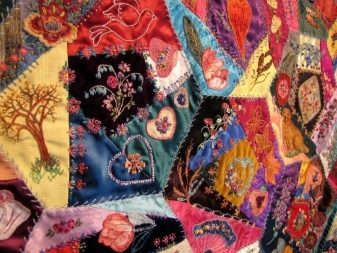
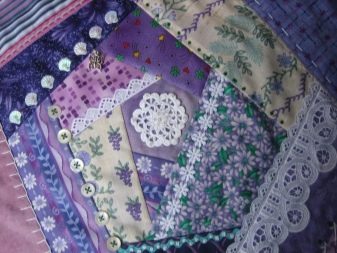
Crazy patchwork has many attractive sides, one of which is creative freedom. First, the needlewoman copies the stitches, then she comes up with her own, then she makes things unique, not spied anywhere.
For more details on the Crazy Patchwork, see the video.








